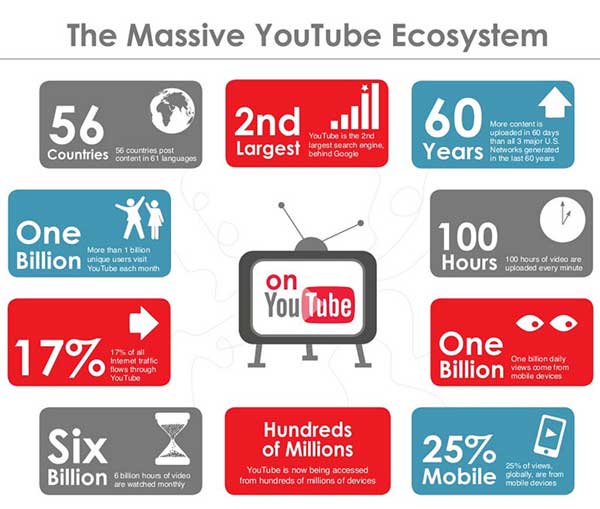
Navigate an unpredictable landscape with actionable, data-driven strategies tailored for your business from the brand down to the local level.

A few clients have been asking for tips on how best to improve the visibility of their videos in YouTube so I thought I would create a public post to share.
There are obvious benefits to embedding videos into the pages on your website. Because Google and modern users prefer rich media, that page can get a potential rankings boost. It will also keep your audience interacting with your own domain and will be easier to push them farther down the conversion funnel. The key issue is, however, that the only people who will see that video are the people who find the page.
The easiest way to get more eyes on your videos is to host them on third-party platforms such as YouTube (the world’s second-largest search engine) or Vimeo etc. This will not only increase your brand exposure and get your products in front of more people (see the unbelievable stats below) you can actually send people directly back to your site through links and annotations.

Source: Lisa Jahred
However, with 300 hours of new video content being uploaded every minute, it can be difficult to be heard over the noise. We’re here to help.
Like Google, YouTube has its own internal algorithms which evaluate the best result to show a particular user for a particular query. Below are the main factors to keep front of mind when uploading your video to YouTube.
Watch Time:
YouTube wants to understand how people are engaging with your video. The longer people watch it for, the more relevant the video is assumed to be for the search term in question. Aim to keep people engaged throughout your video. It is getting more and more common to use animations, effects, plotlines and narratives, music, conversation, countdown formats etc. to help keep viewers focused for as long as possible.
Keyword Relevance:
Google is still not able to effectively understand video content so it relies on the uploader providing accurate descriptions. These are the most important elements to remember with regards to keywords:
Video Title
Tags
Subscribe to our monthly newsletter.
Google still uses tags to help understand the subject matter of a video, and ultimately to help it rank it effectively and serve it up to the right people. Use as many relevant terms here as you can. There are various helpful tools such as Tag Generator, which is a good place to start.
Description
Again, this should be used to accurately describe the content of the video to help lower bounce rate and serve it up to the right people.
The description should contain your most valuable keywords but should, again, also sell the video to the viewer and highlight its value to them.
We recommend going into as much detail as possible here. Many successful videos often contain a transcript of all dialogue or spoken word to help Google better understand the content.
Number of Subscribers:
The more subscribers your channel has, the more valuable it is perceived to be by YouTube. Videos from channels with lots of subscribers will be prioritised in results.
Tips for increasing your subscriber count:
Interaction and Engagement Metrics:
YouTube will use metrics such as comments, shares, likes and dislikes to inform your rankings. Again, you can ask your viewers to like and share but the best tactic here is to simply understand your audience and what they’re looking for, make your content as engaging and useful as possible for them, and describe it accurately so it doesn’t get served up to the wrong people.
Video Quality:
As you might expect in 2017, the standard YouTube user expects high-quality videos. High-quality videos will rank higher than those of low quality. The latter are also likely to suffer from poor engagement metrics, further affecting their ability to rank.
Views:
The more views a video receives the higher it will rank. Share your videos with your clients, email list and across your social channels to increase the number of views. Also, try promoting them on your own blog, relevant industry forums as well as bookmarking sites such as Quorra or Reddit.
Video Length:
There is a bit of a balancing act here. As a rule, it is generally agreed that, like long-form articles in Google, longer videos rank better in YouTube. If you search for broad terms, such as Mortgages four of the top five are longer than 10 mins (some considerably so).
The flip side of the coin is that, in general, users don’t want to sit down and watch long videos. Short videos will get better engagement metrics and fewer bounces. They’re also likely to get more views (depending on the topic) as people are more willing to invest 5 minutes in a new video than 20 minutes or more.
Overall, the benefits of shorter, quicker videos seem to outweigh the benefits of longer videos.
We suggest making lots of short, concise videos which each deal with a very narrow topic or question. This is also more helpful for the user browsing your channel looking for something specific and will give you more opportunities to show up in YouTube search.
Contact DAC if you have any specific questions about optimising your video content.
Navigate an unpredictable landscape with actionable, data-driven strategies tailored for your business from the brand down to the local level.
Navigate an unpredictable landscape with actionable, data-driven strategies tailored for your business from the brand down to the local level.
Navigate an unpredictable landscape with actionable, data-driven strategies tailored for your business from the brand down to the local level.
Subscribe to our monthly newsletter.